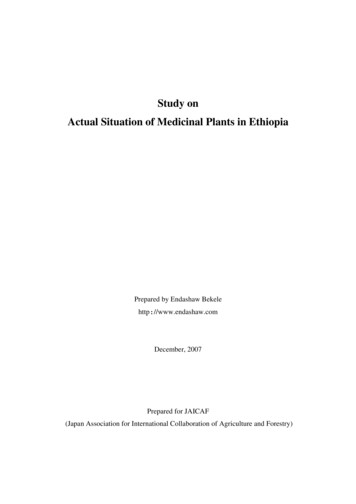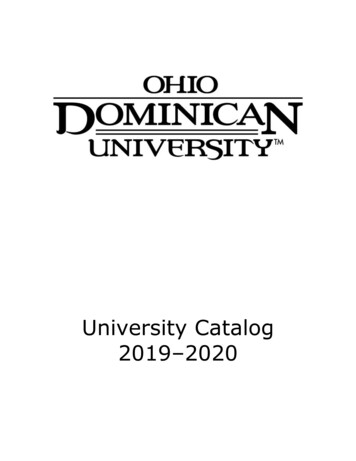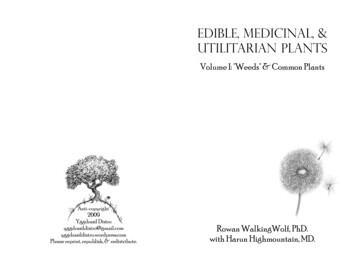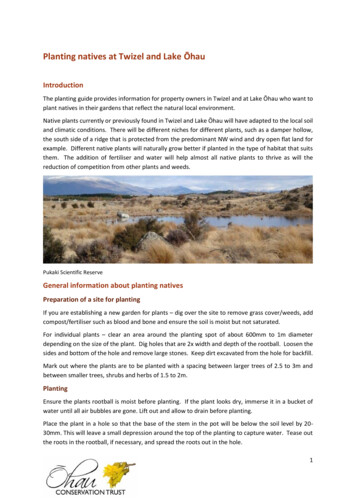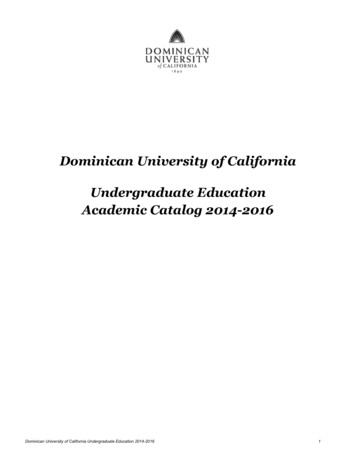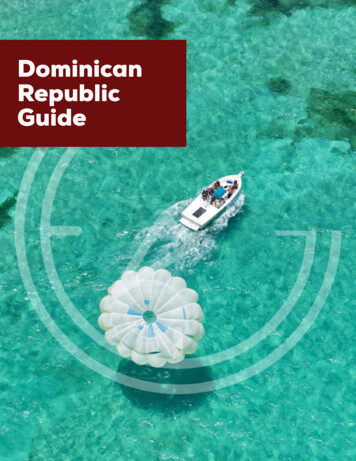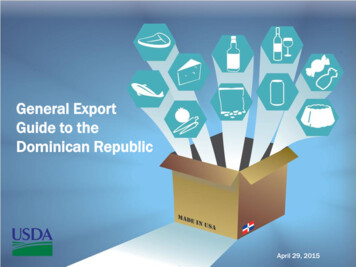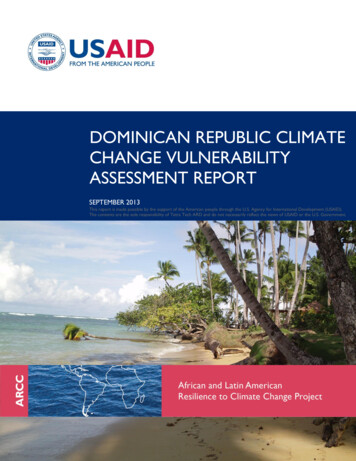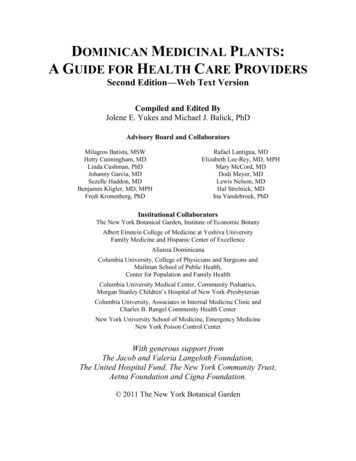
Transcription
DOMINICAN MEDICINAL PLANTS:A GUIDE FOR HEALTH CARE PROVIDERSSecond Edition—Web Text VersionCompiled and Edited ByJolene E. Yukes and Michael J. Balick, PhDAdvisory Board and CollaboratorsMilagros Batista, MSWHetty Cunningham, MDLinda Cushman, PhDJohanny García, MDSezelle Haddon, MDBenjamin Kligler, MD, MPHFredi Kronenberg, PhDRafael Lantigua, MDElizabeth Lee-Rey, MD, MPHMary McCord, MDDodi Meyer, MDLewis Nelson, MDHal Strelnick, MDIna Vandebroek, PhDInstitutional CollaboratorsThe New York Botanical Garden, Institute of Economic BotanyAlbert Einstein College of Medicine at Yeshiva UniversityFamily Medicine and Hispanic Center of ExcellenceAlianza DominicanaColumbia University, College of Physicians and Surgeons andMailman School of Public Health,Center for Population and Family HealthColumbia University Medical Center, Community Pediatrics,Morgan Stanley Children’s Hospital of New York-PresbyterianColumbia University, Associates in Internal Medicine Clinic andCharles B. Rangel Community Health CenterNew York University School of Medicine, Emergency MedicineNew York Poison Control CenterWith generous support fromThe Jacob and Valeria Langeloth Foundation,The United Hospital Fund, The New York Community Trust,Aetna Foundation and Cigna Foundation. 2011 The New York Botanical Garden
IMPORTANT NOTICE:This book is a work of reference and is not intended to medically prescribe or promote anyproduct or substance, nor is it intended to replace medical care. Readers should consult with aqualified physician or health care provider before administering or undertaking any course ofmedical treatment. No endorsement of any product or substance is implied by its inclusion in thisbook. Even plants that are commonly consumed as food and reported to be generally recognizedas safe may have adverse effects, including drug interactions and allergic reactions in someindividuals. The authors, editors and publisher disclaim all warranties, expressed and implied, tothe extent permitted by law, that the contents are in every respect accurate and complete, andthey are not responsible for errors, omissions or any consequences from the application of thisbook’s contents.2
Este libro está dedicado a la comunidad Dominicana de la Ciudad de Nueva York, yespecialmente a las/los especialistas en plantas medicinales, dueñas/dueños y trabajadores debotánicas, curanderas/curanderos, espiritistas, santeras/santeros y otra gente que ha dado susabiduría y tiempo con tanta generosidad para hacer posible esta publicación.This book is dedicated to the Dominican community of New York City and especially to theherbalists, healers, botánica proprietors and staff, espiritistas, santeras/santeros and others whohave so generously given of their time and knowledge to make this publication possible.3
ACKNOWLEDGEMENTSMany people have contributed their time, support and expertise to the compilation andpreparation of this reference manual. First we would like to express our profound gratitude to theDominican community in New York City, particularly to those individuals who have shared with us theirknowledge of herbal medicine and healing traditions from the Dominican Republic. Although they willremain anonymous for purposes of confidentiality, this publication would not have been possible withouttheir collaboration.We extend our deep appreciation to the Jacob and Valeria Langeloth Foundation for generouslysupporting not only the preparation and publication of this manual, but also for the integration of thisguidebook into cultural competency training programs for health care providers in New York City. Inaddition, we gratefully acknowledge The United Hospital Fund and The New York Community Trust fortheir most generous support of the compilation of the first edition of this manual and the pilot-testing of apreliminary version of this publication.Researching, preparing and editing this volume has been a collaborative endeavor from thebeginning, involving partnerships with the following organizations and institutions: The New YorkBotanical Garden, Institute of Economic Botany; Albert Einstein College of Medicine at YeshivaUniversity, Family Medicine and Hispanic Center of Excellence; Alianza Dominicana; ColumbiaUniversity, College of Physicians and Surgeons, Associates in Internal Medicine Clinic and MailmanSchool of Public Health, Center for Population and Family Health; Columbia University Medical Center,Community Pediatrics; New York-Presbyterian Hospital, Charles B. Rangel Community Health Centerand Morgan Stanley Children’s Hospital; New York University School of Medicine, EmergencyMedicine; and the New York Poison Control Center.We extend our sincere appreciation to the many wonderful research assistants, interns andvolunteers whose efforts have contributed to the making of this book: Yadira Arias, Levenia Durán,Jessica Fried, Saralinda Lugo Hart, Athalia Caro Keffield, Saneddy Quezada and Sam Stein. In particular,we wish to thank Frans Beltran, Dr. Algernon Churchill, Jillian De Gezelle and Rachel Corey-Pachecowho helped considerably with data analysis and MEDLINE literature research. The following designprofessionals contributed their talent, creativity and skills to the graphics and layout of this publication:Marilan Lund, Ben Munson and Doris Straus.Several clinicians and other medical experts have pilot-tested or reviewed portions of the contentsof this manuscript and offered helpful feedback and suggestions. We wish to recognize and thank themfor their insightful contributions: Matthew Anderson, MD; Mark Blumenthal; Hetty Cunningham, MD;Norm Farnsworth, PhD; Deborah Finkelstein, MD; Robin Flam, MD; Anna Flattau, MD; Johanny Garcia,MD; Melanie Gissen, MD; Sezelle Haddon, MD; Emily Jackson, MD; Pablo Joo, MD; Elaine Fleck, MD;Edward Kennelly, PhD; Nicole Kirchen, MD; Ben Kligler, MD; Kathleen Klink, MD; Fredi Kronenberg,PhD; Rafael Lantigua, MD; Roberta Lee, MD; Mary McCord, MD; Gretchen Mockler, MD; MelanieRausche, MD; Pran Saha, MD; Lionel Robineau, MD; Vincent Silenzio, MD; Ellen Tattelman, MD; andRobert Wolkow, MD.Numerous individuals have granted us permission to use their photographs, illustrations ordigitized images of plants for this publication, and we appreciate their willingness to share their artisticwork so that this volume could be fully illustrated: Irina Adam, Francesca Anderson, Michael J. Balick,PhD, Bruce Hoffman, PhD, Edward Kennelly, PhD, Andreana Ososki, PhD, Ina Vandebroek, PhD, KeithWeller and Jolene Yukes. For more information on photographers and their photographs, please see:“Appendix C: Photo Credits.”The ethnobotanical information in this book is the culmination of more than ten years ofethnomedical research in the New York City area. As such, we wish to acknowledge the efforts ofcollaborators and co-investigators from the Urban Ethnobotany Project, a previous ethnomedical researchinitiative which paved the way for the present endeavor: Fredi Kronenberg, Marian Reiff, AndreanaOsoski, Kimberly Johnson, Patricia Lohr, Maria Roble, Bonnie O’Connor, Adriane Fugh-Berman and4
Gilda Pérez. We thank the Rosenthal Center for Complementary and Alternative Medicine Research atColumbia University for their long-standing partnership and collaboration over many years. Finally, wegratefully acknowledge the Educational Foundation of America for their support for the ethnobotanicaland medical anthropology research on Dominican traditional medicine in New York City upon which thisbook was initially developed.Additional information on Dominican medicinal plants and their uses has been added to thisrevised edition of the guidebook based on the preliminary results of the “Dominican Ethnomedicine inNew York City” project funded by an R21 grant from the National Institutes of Health, National Centerfor Complementary and Alternative Medicine (Principal Investigator: Michael J. Balick, PhD; Grant #R21-AT001889). We sincerely thank Dr. Ina Vandebroek, the director of that project, who has generouslyshared this information with us to enhance the scope and relevance of the ethnomedicial data in thispublication. She wishes to extend her gratitude to the following research assistants, interns and volunteerswho assisted her with this project: Yadira Arias, Frans Beltran, Tomas Diaz, Levenia Durán, AshleyDuval, Daniel Kulakowski, Greta Meyers, Saneddy Quezada, Claudia Remes, Kate Sokol, Samuel Steinand Margaret Terrero.At The New York Botanical Garden, Michael J. Balick is a MetLife Fellow, and we gratefullyacknowledge the following foundations which have supported his work on this project: The MetLifeFoundation, Edward P. Bass and the Philecology Trust, the Prospect Hill Foundation and the FreedFoundation.Finally, as the primary authors of this guidebook, we express our heartfelt gratitude and sincereappreciation to our family and friends for their support and encouragement throughout the process ofwriting and editing this publication. Jolene Yukes gives special thanks to Anthony Louis Piscitella for hispatience, support and joyful companionship throughout the compilation of this manuscript.5
TABLE OF CONTENTSPart 1Introduction and How to Use this BookPart 2Quick Guide to Dominican Home RemediesPart 3Medicinal Plant MonographsAPPENDICESA. Key to Abbreviations and SymbolsB. Glossary of Botanical Terms6
PART 1INTRODUCTION AND HOW TO USE THIS BOOK:BACKGROUND, METHODS AND EXPLANATION OF LAYOUTINTRODUCTIONDuring ethnomedical interviews while conducting fieldwork for this publication, practitioners oftraditional medicine from the Dominican Republic repeatedly responded with the same popularexpression when asked about medicinal plants: “Hay plantas que curan y plantas que matan (There areplants that heal and plants that kill).” This wise saying encapsulates one of the primary goals of this book.Knowing the difference between potentially harmful substances and beneficial therapies is of crucialimportance for anyone, especially health care providers and individuals who self-medicate with herbalremedies.However, sometimes the difference between potentially toxic vs. safe therapies is not as clear-cutas it might seem at first glance. As physicians have known since the time of Paracelsus, the differencebetween poison and medicine is in the dose. Even foods or pharmaceutical drugs that are generallyregarded as safe can be toxic or cause adverse effects depending on the context of their use. Herb-druginteractions are another important concern as research has shown that many popular botanical therapiesmay negatively affect drug metabolism. Reliable information on the safety, contraindications andpotential drug interactions of complementary and alternative therapies is needed now more than everbefore. Although abundant research data is available for mainstream dietary supplements and herbs, verylittle attention has been given to the botanical therapies and traditional remedies used by immigrantcommunities and minority ethnic groups here in the United States, particularly among low-income andunderserved populations.In an era of globalization characterized by increasing urbanization and transnational migration,health care providers frequently encounter patients from diverse backgrounds. Clinicians may not speakthe same language as their patients or be familiar with their health-related cultural beliefs and practices,some of which may affect adherence to treatment protocols and health outcomes. With widespread use ofcomplementary and alternative therapies, including traditional herbal remedies, how can cliniciansdetermine the safety of the non-pharmaceutical therapies that their patients may be using, especially ifthey are unfamiliar or referred to by regional vernacular or unknown names? The primary aim of thisbook is to address these questions with respect to immigrants from the Dominican Republic in New YorkCity by providing information on traditional Dominican uses of medicinal plants and a review of theavailable scientific literature on their safety and efficacy.The present volume, Dominican Medicinal Plants: A Guide for Health Care Providers, isintended as a reference manual for clinicians to support culturally effective health care and greaterunderstanding of the traditional medical practices of immigrants from the Dominican Republic in NewYork City. By providing information about complementary and alternative therapies, including traditionalherbal remedies, among Latino/Caribbean immigrants in the United States, this book can be used to helpfacilitate informed dialogue and enhance disclosure regarding patients’ use of medicinal plants. As aninformational and educational tool, this book can support patient-provider communication and enhancecross-cultural understanding in a clinical setting. In addition to information about the plants themselves,this guidebook also provides explanations of key ethnomedical concepts and customs related to the use ofherbal medicine to clarify the cultural context of Dominican ethnomedical traditions.Ultimately, the main goal of this guidebook is to enhance the quality of patient care forDominicans in New York City by supporting informed patient-provider communication and raisingawareness about the use of home remedies and their relevance to health care. We sincerely hope that thisbook can serve as a model for other educational initiatives to enhance the quality of health care for7
underserved, minority or immigrant populations with strong traditions of herbal medicine throughrelevant cultural competency training and curricular materials.The ethnobotanical information in this book is based on ongoing ethnographic fieldworkconducted in New York City with immigrants from the Dominican Republic between 1995-2009.Although there are notable cross-cultural similarities between traditional medical practices amongSpanish-speaking populations from different Latin American countries, the reader is advised that commonnames and ethnomedical uses of medicinal plants may vary considerably between differentLatino/Hispanic cultural groups or even within a particular community. Therefore, the Dominicanethnomedical information included in this book may not reflect the herbal medicine practices of otherLatin American or Caribbean populations. Please keep this regional and cultural specify in mind whenreading this book.BACKGROUNDBeginning in 1985, researchers from The New York Botanical Garden’s Institute of Economic Botany, incollaboration with scientists and medical doctors from The Richard and Hinda Rosenthal Center forComplementary and Alternative Medicine at Columbia University’s College of Physicians and Surgeonshave worked with traditional healers from diverse immigrant communities in New York City to documenttheir use of medicinal plants. In 1995, this research team chose to focus on Dominican healing traditionsas practiced in an urban, cosmopolitan setting and conducted ethnobotanical research with specialists inDominican herbal medicine from predominantly Latin-American and Caribbean immigrantneighborhoods in the Bronx and Northern Manhattan.Since that time, researchers have documented detailed information on the ethnobotany andethnomedicine of commonly used medicinal plants, particularly within the context of women’s health andgeneral concepts of disease etiology (see Balick et al. 2000, Ososki et al. 2002, Reiff et al. 2003, Yukes etal. 2003). In 2005 ethnobotanists from The New York Botanical Garden (NYBG), in collaboration withinstitutions in the United States and the Caribbean, initiated a comparative survey entitled: “DominicanEthnomedicine in New York City and the Dominican Republic: Medicinal Plants for Common HealthConditions.” The purpose of this survey was to study the use of medicinal plants by Dominicans in NewYork City and the Dominican Republic, investigating both generalist knowledge (i.e. of laypersons whoself-medicate with home remedies) and specialist knowledge (i.e. of healers and practitioners ofDominican traditional medicine).This project, supported by an R21 grant from the National Institutes of Health (NIH), NationalCenter for Complementary and Alternative Medicine (NCCAM; grant number R21-AT001889, PrincipalInvestigator: Michael J. Balick, PhD), included questions about herbs used for a wide range of commonhealth conditions (Vandebroek et al. 2007). As a result of the past decade of research on Dominican urbanethnomedical practices, the authors embarked on the present applied research project to facilitate thedissemination of information on Dominican medicinal plants to health care providers who work withDominican patients.Throughout the preparation of this publication, the authors have collaborated with an AdvisoryBoard consisting of physicians, ethnobotanists, medical anthropologists and representatives fromDominican community-based organizations (see “Advisory Board and Collaborators” listed on the titlepage. The present volume is the result of the combined efforts of the following organizations: The NewYork Botanical Garden, Institute of Economic Botany; Albert Einstein College of Medicine at YeshivaUniversity, Family Medicine and Hispanic Center of Excellence, Alianza Dominicana; CommunityPediatrics, New York-Presbyterian Hospital; and Columbia University College of Physicians andSurgeons, Mailman School of Public Health, Center for Population and Family Health; ColumbiaUniversity Medical Center, Community Pediatrics, Morgan Stanley Children’s Hospital of New YorkPresbyterian; Columbia University, Associates in Internal Medicine Clinic and Charles B. RangelCommunity Health Center; New York University School of Medicine, Emergency Medicine and the New8
York Poison Control Center. Support for this project was generously provided by the United HospitalFund, The New York Community Trust and The Jacob and Valeria Langeloth Foundation.From January through March 2006, the first edition of this guidebook was pilot tested with aselect group of twenty-five health care providers and medical professionals in the New York City area.The goal of this pilot testing was to determine the usefulness of this book as a clinical reference and as atool for facilitating cultural understanding in a primary care setting. Participants in this pilot-testing phasecompleted a short survey after consulting the book, evaluating its relevance, ease-of-use and efficacy insupporting culturally sensitive and knowledgeable discussion of the use of botanical therapies withDominican patients. Feedback and suggestions for improvement from these pilot-testing surveys havebeen incorporated into the revised second edition of this guidebook.METHODSThis reference manual is a synthesis of three general disciplines, each encompassing different types ofinformation and involving unique methodological approaches: 1. medical ethnobotany and anthropology:original ethnomedical and ethnobotanical research on the use of herbal remedies by Dominicans in NewYork City for common health conditions; 2. botany and taxonomy: collection of botanical specimensutilized by Dominicans in healing and taxonomic identification of commonly used medicinal plants todetermine their Latin binomial (genus and species); and, 3. biomedical literature research: a review of theavailable scientific literature on the safety and efficacy of selected medicinal plants, including databasesearches of published results from toxicology and pharmacology studies.Ethnobotany and Medical AnthropologyEthnobotany is the study of the complex relationships between people and plants, such as cultural beliefsand practices associated with the use of plants for food, medicine and ritual, local systems for naming andclassifying plants species, traditional knowledge about ecological relationships and botany-related songs,stories and legends. Medical anthropology, including the sub discipline ethnomedicine, is the academicfield devoted to the cultural dimensions of medicine and health care, including traditional systems ofhealing. Both disciplines are interrelated, especially medical ethnobotany and ethnomedicine, and arehighly relevant to health care in an era of medical pluralism in which multiple systems of medicineoperate simultaneously. In this book, the term “traditional medicine” is used to describe medicaltraditions, health beliefs and healing practices that historically have been passed down orally and whichare typically associated with a particular cultural group or region. Traditional medicine is a type ofcomplementary and alternative medicine (CAM) that is often used alongside, in combination with orinstead of allopathic medicine and may incorporate elements of conventional health care, such aspharmaceutical pills or injections, terminology and diagnostic techniques. The terms “biomedicine” or“conventional medicine” are used to describe allopathic health care, particularly the dominant system ofstandard practice medicine.Dominican health-related cultural practices and beliefs as reported in this guidebook are based onresearch conducted using ethnomedical and ethnobotanical methods. These methods include semistructured interviews, exploratory ethnography, market studies, participant-observation and qualitativedata analysis. Study participants were identified through informal social networks. Both specialists andgeneralists in Dominican herbal medicine were interviewed. Specialists were defined as recognizedexperts in plant-based healing, such as herbalists and practitioners of traditional medicine, whereasgeneralists included individuals who reported that they used home remedies for self-care or sought thehealth advice of traditional healers but were not considered experts themselves. All study participantsstated that they acquired their knowledge of medicinal plants while in the Dominican Republic or fromDominican family members, friends, relatives or healers in the United States.All interviews were tape-recorded and transcribed. Interview questions addressed the followingtopics: concepts of health and illness, disease etiology, anatomical terms, methods of diagnosis, spiritualaspects of healing, treatment choice and health decision making. Results were entered into a MS Access9
database and interview transcripts were coded using qualitative data analysis software (Atlas.ti). Plantsincluded in this book were selected based on their frequency of use as reported by more than one of thefollowing sources: traditional healers, herbal specialists at Latino herb shops (botánicas) or Dominicanstudy participants who use plant-based home remedies and prepare them for family members andrelatives.Botany and Plant TaxonomyOne key component of ethnobotanical research is determining the correct scientific name for Dominicanmedicinal plants because the biomedical literature on botanical therapies is typically indexed by Latinbinomial rather than the Dominican Spanish common name as reported by participants in ethnobotanicalinterviews. To determine the correct scientific names of medicinal plants included in this guidebook,botanical specimens were collected whenever possible for identification by ethnobotanists and planttaxonomy specialists at The New York Botanical Garden. However, since most plants used were onlyavailable as food items from grocery stores or sterile plant fragments, in many cases a reference collectionof plant photographs and purchased plant material was used.The following references were consulted to determine the appropriate botanical descriptions,synonyms, family classification and spelling of authors for each species: Angiosperm Phylogeny Website(Stevens 2008), Diccionario Botánico de Nombres Vulgares de La Española (Liogier 2000), Flora of St.John (Acevedo-Rodríguez 1996), Harvard University Herbaria Index of Botanists, International PlantNames Index (Stevens 2008), International Plant Names Index (IPNI 2004), Manual of Vascular Plants ofNortheastern United States and Adjacent Canada, Second Edition (Gleason & Cronquist 1991) and theMissouri Botanical Garden's VAST (VAScular Tropicos) nomenclatural database (VAST 2008).Additional botanical references consulted are cited in the “Botanical Description” section of eachmonograph.Because of the importance of knowing the genus and species for plant-based home remedies inorder to evaluate the scientific literature on their safety and efficacy, botanical research institutions suchas The New York Botanical Garden can play a unique role in mediating between the realms of traditionalhealing systems and biomedical health care.Biomedical Literature ResearchTo compile relevant biomedical literature on the safety and efficacy of medicinal plants included in thisguidebook, several databases and references have been consulted. For clinical, preclinical (in vitro and invivo), pharmacological and toxicity studies of the plants in this book, searches for the scientific name(Latin binomial) and English common name, when appropriate, of each plant species were conducted inPubMed (http://www.ncbi.nlm.nih.gov/PubMed/). Additional information was compiled from thefollowing databases: BIOSIS (http://www.biosis.org/), FDA GRAS(http://www.cfsan.fda.gov/ lrd/fcf182.html), Jim Duke’s Phytochemical Database (http://www.arsgrin.gov/duke/), NAPRALERT (http://www.napralert.org/), ToxNet (http://toxnet.nlm.nih.gov/) and theUSDA Nutritional Database (http://www.ars.usda.gov/nutrientdata).For information on safety, precautions, biological activity, indications and usage, reliable clinicalreferences were consulted, including: A Caribbean Herbal Pharmacopoeia (Germosén-Robineau 2007),The 5-Minute Herb and Dietary Supplement Consult (Fugh-Berman 2003), the German Commission EMonographs (Blumenthal et al. 1998) and the Physicians Desk Reference for Herbal Medicines(Gruenwald et al. 2004). For information on contraindications and potential drug interactions, the abovesources as well as Herb Contraindications and Drug Interactions, 2nd Ed (Brinker 1998) were consulted.Many of these books, particularly publications by TRAMIL such as A Caribbean Herbal Pharmacopoeia,served as informative models for the organization and presentation of information in this volume.For all reported studies from the biomedical literature, it is important to pay attention to the plantpart used, form of preparation and mode of administration evaluated in each experiment. Those thatreflect traditional uses are most relevant. When available, data from randomized, double-blind, placebo10
controlled clinical trials is given priority over preclinical studies. However, many plant species have notbeen tested in humans.Preclinical and laboratory studies are also included in this guidebook, even though generally theirresults cannot be applied to humans. Such in vitro and in vivo studies may be useful when they validatetraditional uses of medicinal plants or when they elucidate biological activities that may interfere withmedication or other therapies. For example, if a particular plant is applied topically as an herbal remedyfor dermatological conditions, in vitro or animal studies that demonstrate the antimicrobial or antiinflammatory activity of the traditional preparation of the plant could support or validate its external useas long as the plant has been shown to be nontoxic.It is important to keep in mind that considerable variation exists in the amount of publishedclinical and pharmacological research available for a given plant. For example, widely used plants such asajo (garlic, Allium sativum) and sábila (aloe, Aloe vera) have been studied extensively in human clinicaltrials and laboratory studies; however, for other plants that are lesser known outside of the Caribbean andLatin America, such as batata de burro (Caribbean coralfruit, Doyerea emetocathartica), very littleinformation is available on their pharmacological activity or clinical applications. Plants for which moreresearch has been conducted (particularly those that are sold commercially on a large scale) will havemore information available on safety, contraindications, herb-drug interactions and clinical applications.Other less-studied plants may also have important contraindications and herb-drug interactions, but notenough research has been conducted on their use in conjunction with medications and in specialpopulations to be able to provide this information. In many cases, a plant species’ relative safety orefficacy cannot be determined based on the available data.CONTENT AND LAYOUT OF THIS GUIDEBOOKSeveral clinical references on botanical medicine have served as informative models for this guidebook.In particular, the following publications were key references in the preparation of this manual: theCaribbean Herbal Pharmacopoeia, Second Edition (Germosén-Robineau 2007), the German CommissionE Monographs (Blumenthal et al. 1998), the Physicians Desk Reference for Herbal Medicines(Gruenwald et al. 2004) and other clinical guides for herbal medicine (Brinker 1998, Fugh-Berman 2003).These references provide reliable information about the therapeutic applications of botanical therapies,including both traditional cultural uses (historical and contemporary) and biomedical data, such aspharmacological activity, clinical trials, chemical constituents, herb-drug interactions, contraindicationsand indications and usage. All of the above publications were consulted extensively in the preparation ofthis manuscript.Most notably, the publications of the non-governmental organization TRAMIL (formerly knownas “Traditional Medicine in the Islands”) have inspired and informed the approach of this guidebook.TRAMIL is a multidisciplinary network dedicated to applied research on medicinal plants of theCaribbean region. In addition to the Caribbean Herbal Pharmacopoeia, Second Edition (in Spanish andEnglish, Germosén-Robineau 2005 & 2007), other TRAMIL publications include several volumes ofElements for a Caribbean Pharmacopeia (Germosén
Albert Einstein College of Medicine at Yeshiva University Family Medicine and Hispanic Center of Excellence Alianza Dominicana Columbia University, College of Physicians and Surgeons and . and medical anthropology research on Dominican traditional medicine in New York City upon which this book was initially developed.
